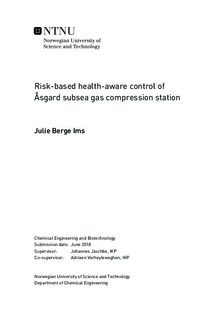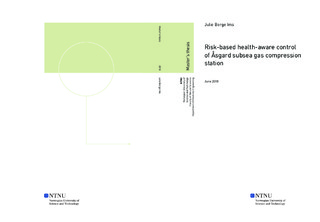| dc.description.abstract | Safe and efficient operation of subsea processing systems imposes strict requirements with
respect to equipment design and reliability. This is to avoid accidental shutdowns, which
can lead to expensive maintenance engagements. For that reason, health monitoring methods
are applied to monitor and evaluate the condition of the overall system in real-time.
However, when finding the optimal operation policy, the health condition is generally not
reviewed directly. As a consequence, this may cause overly restrictive operation. This
study will suggest to combine control and condition monitoring of the A° sgard gas compression
station, in order to prevent the operation policy from being sub-optimal. In this
manner, the obtained optimal plan of action for operation will seek to sustain the reliability
of the subsea system. This makes it possible to forecast the health of the system and
manage the operation accordingly, rather than just reacting to it.
This thesis proposes a model predictive control (MPC) approach for integrating health
monitoring and control. The scheme will seek to ensure safe operation and an economic
optimal control policy for the subsea station. Risk measures that estimate the risk of failure
are used for condition monitoring purposes. In this work, Conditional Value-at-Risk
(CVaR) with respect to the random variable remaining useful life (RUL) of equipment is
incorporated into the optimal control problem to assess the condition of system equipment.
CVaR estimates the risk of failure in a conservative manner by bringing the extreme
RUL of equipment outcomes into focus for a confidence level, . The theoretical analysis
shows that minimization of unavailability of equipment coincides with the maximization
of CVaR with respect to RUL of equipment. Control of the predicted CVaR with respect
to RUL of equipment is employed to enforce safe operation until the next maintenance
engagement.
The numerical simulations show that the predicted CVaR with respect to the RUL of equipment
decreases with time until the next maintenance engagement, which is scheduled to
happen in five years. The average RUL of the 0.1% worst RUL outcomes has been calculated
to be to just above five years at the startup of the plant. A higher confidence level
gives rise to higher values for CVaR with respect to RUL of equipment. In this approach,
maximizing profit in terms of gas production while maximizing average RUL of the 0.1%
worst RUL outcomes gives a production profile where the gas production rate decreases
with time.
The overall conclusion from this work is that health-aware control with risk measures
for condition monitoring has the potential to manage the reliability of a subsea plant. Nevertheless,
the accuracy of the system model and the implementation of the risk measure
estimate influence the ability of the controller to predict the risk of failure. | |

